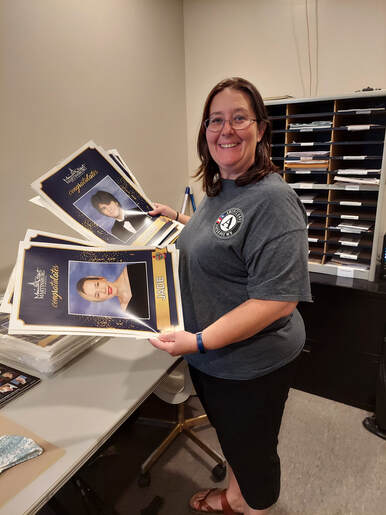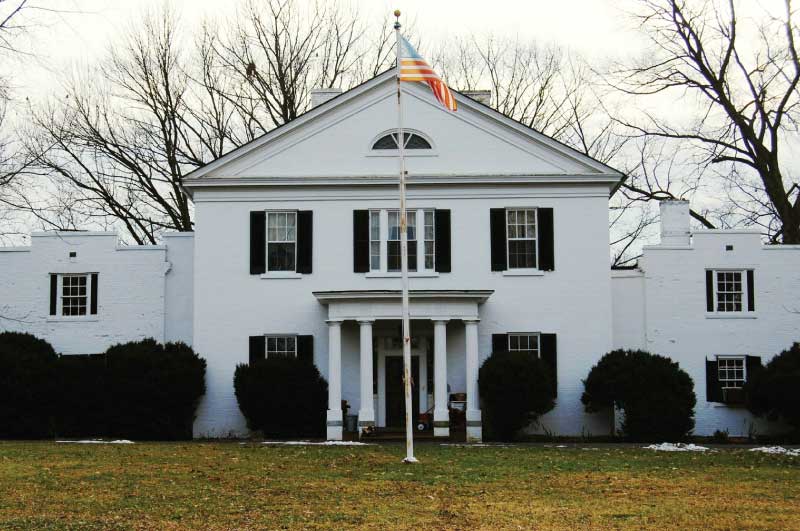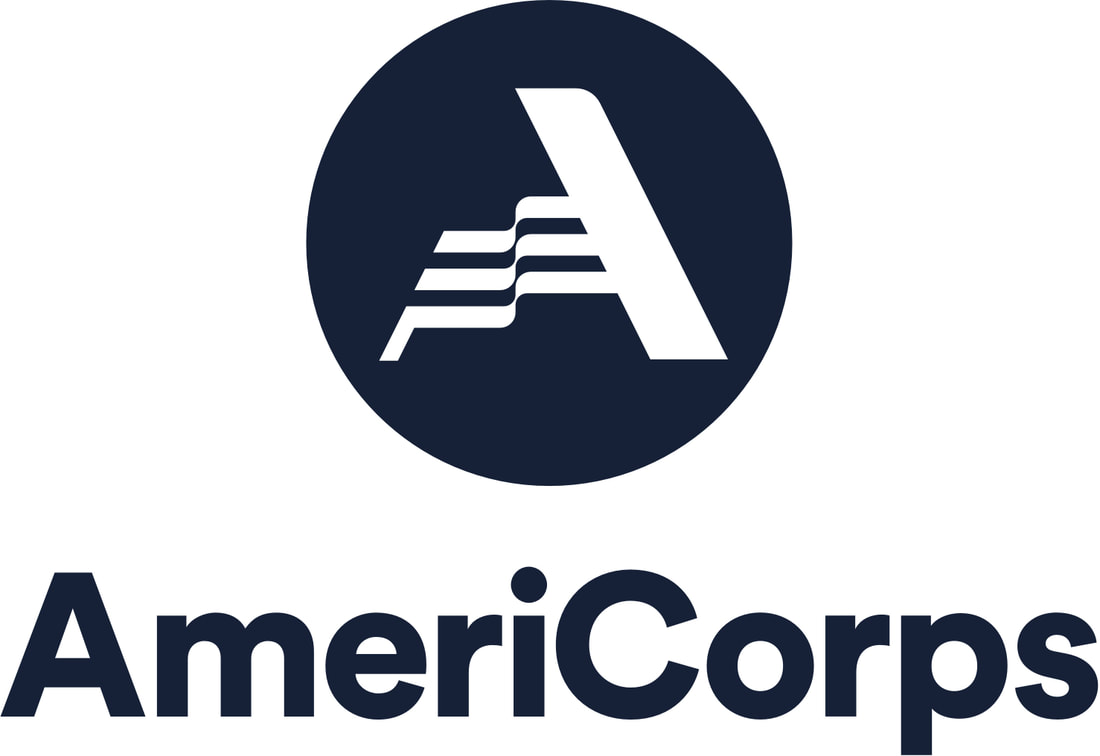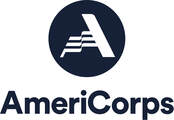|
During the past year, I made several trips to Ronceverte to help organize the city museum at its new location on the second floor of the Clifford Recreation and Community Center, following the sudden passing of Doug Hinton, the long-time curator of the museum. My primary objective was to inspect more than 50 boxes of artifacts and documents and prepare a computerized catalogue of the contents, which I completed. In a random box, I discovered an incredible, priceless piece of West Virginia history: a 1796 land deed from the Governor of the Commonwealth of Virginia to Alexander Robison of Greenbrier County! It was folded firmly and stored in an envelope for many years, and I refused to harm a 200+ year old document by attempting to unfold it. Instead, I found a donor and researched a firm that could safely unfold, flatten, and frame the deed. I found a professional artifact restoration firm in Ohio, Old World Restorations in Cincinnati. They did an amazing job of safely unfolding the deed document, flattening it, and framing it in archival glass. I was proud to hand-deliver the framed deed to Mayor Smith in Ronceverte in April 2021. I discovered many other gems in the Ronceverte Museum’s collection. Highlights from the 50+ boxes include the following: 1. 3 body tags with wire attached with notes from coroner; two have no date, but one is marked 'found May 23, 1963.' 2. 1880 Two small original photographs of West Virginia native Pearl S. Buck's parents Reverend Absalom Sydenstricker and Mrs. Caroline Stulting Sydenstricker in 1880. 3. "Good for 5 cent" tokens, five total. Rare. Often called trade coins, they were especially used after the Civil War as a substitute medium of exchange instead of nickels; they had limited use and were often issued by a private company, group, association or individual. 4. 1890s-1902, Set of funeral home or cemetery plot records in delicate, damaged condition. Interesting look into what people died of in Ronceverte in the late 19th and early 20th century. One page has a record of a black man who was killed, but he was not given the dignity of his name, age, date of death and location like the white West Virginians on the other pages.. 5. 1881-1889, book of State of West Virginia court judgements. If you take the time to read the handwriting, it has an interesting look into what was brought to court in late 19th century West Virginia. 6. 1885-1887, three autograph books; two of Nellie Longfellow, one of Laura Forgelson. Very cute entries from school friends and family members. 7. Some kind of Ronceverte athletic uniform from the 1950s-1970s of a top and shorts, jockstrap included! 8. White folder with material relating to petitioning Colonel Clifford of Ronceverte for the Medal of Honor. He served with distinction in World War II and the community center housing the Ronceverte museum is named after him. It is worth noting because not many people know about what goes into the process of petitioning for a Medal of Honor. 9. Register of Hotel Dickson, Ronceverte 1888, including a signature of President Glover Cleveland with a cute notation “and Mrs. C” from October 11th, 1888! During my final visit to Ronceverte at the end of my AmeriCorps term, I cleaned all the exhibit cabinets, window wells, and floor. I compiled all my work and ideas for the future of the museum into a Final Report, which I presented to Ronceverte City Administrator Pam Mentz. The report includes suggestions on how the city can engage the local schools and further preserve their collection. The Ronceverte Museum has great potential, and the Final Report for the next AmeriCorps member assigned to Ronceverte will help them build off of my service. It was my sincere pleasure to work with the city of Ronceverte and discover the jewels contained in its museum. Megan Ksenia bradnerMegan Ksenia Bradner served as a Preserve WV AmeriCorps member with the Preservation Alliance of West Virginia during the 2019-2020 and 2020-2021.  The 2019 – 2020 service year for Main Street Martinsburg was going to be a great eventful year full of different activities and events scheduled throughout the whole year. September through January had mixers at different businesses. November and December were full of Christmas events, such as the Christmas Tree lighting and the Christmas Parade. January kicked off the year with a partnership with Healthy Berkeley for Frosty Family Fun Day. February was a planning month where Main Street Martinsburg was gearing up for the main events of the year to include the Chocolate and Book Festival, a wine festival, Fridays @ Five, and we planned to end the AmeriCorps service year with a large event called Boots & Brews. In March, Main Street Martinsburg came to a screeching stop due to COVID-19. Like so many in the world, Main Street Martinsburg had to alter how to help the community. At this time I began to work with executive director, Randy Lewis, to keep the community informed with the daily changes in both the community and with the many different businesses in the Martinsburg Community. Randy and I both started working from home and kept in touch through emails and text. Randy would send me information to post on the website in order to help the community stayed informed, and I would then post on the Main Street Martinsburg’s website. The postings would include information that residents could use, almost daily updates from the state, and other guidelines that the community needed since they changed so often. I also at that time switched the weekly blog of events that were occurring around town to online events that many non-profits were doing to help people while they were staying at home. These included virtual exercise classes, virtual music shows for all ages, virtually connecting with the library, and updates on any of the other non-profits in the community that were available. In May, Main Street Martinsburg decided to help celebrate all of Berkeley County’s High School Senior Graduates. Main Street Martinsburg celebrated the seniors by partnering with some of the local businesses and the Berkeley County Board of Education and had picture posters made and hung them in all the local businesses on Queen Street. These pictures hung until the end of June. Even though during this time I was not able to work with the many volunteers that Main Street Martinsburg has in person, I was at least able to help Randy Lewis with keeping the website updated and help with the senior posters. This allowed me to share with the community an extension of what Main Street Martinsburg was doing to help the community and with the community to stay in touch with both Main Street Martinsburg and Downtown Martinsburg. Even though many of the great events planned did not occur due to COVID-19, these small gestures, I hoped, helped some in the community. SUSAN CrowellSusan Crowell served with Preserve WV AmeriCorps during the 2019-2020 program year where she was assigned to assist the Berkeley County Historical Society and Main Street Martinsburg. PAWV invites YOU to help 3 preservation nonprofits match their AmeriCorps funding NOW!
What is AmeriCorps and Why are these Matches so Important? As you know, each nonprofit that wants to receive an AmeriCorps member has to raise match money. AmeriCorps members are essential to these nonprofits being able to do what each of them does. AmeriCorps members manage volunteers and take the lead on historic preservation projects. Their service is irreplaceable and vital. All donations are processed through the Network for Good webpage and are tax-deductible. Here’s Where Your Money Will Go!
Scope of Work Goals
The Preservation Alliance of West Virginia (PAWV) invites proposals from qualified researchers and consultants to work closely with staff to develop an outcomes-based evaluation plan, process, and tools for the Preserve WV AmeriCorps program based on the program’s theory of change, logic model, and performance measures. The timeline goal is to complete this project and have the evaluation plan and survey tools ready to implement at the start of the 2017-2018 program year, Monday, August 28, 2017. PAWV has existing systems and tools for performance measure data collection, storage, processing, analysis, and reporting, but it is soliciting an external evaluator to improve and standardize these systems and tools, as well as create additional evaluation tools to communicate the impact of the Preserve WV AmeriCorps program with the grantor and general public. |
Preserve WV StoriesCategories
All
Archives
August 2023
|
Get Involved |
Programs |
Contact UsPreservation Alliance of West Virginia
421 Davis Avenue, #4 | Elkins, WV 26241 Email: [email protected] Phone: 304-345-6005 |
Organizational Partners:
© COPYRIGHT 2022 - PRESERVATION ALLIANCE OF WEST VIRGINIA. ALL RIGHTS RESERVED.



 RSS Feed
RSS Feed



